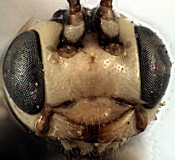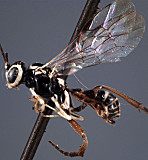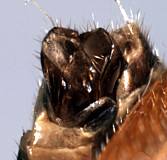Physotarsus gineus Zhaurova, 2009
Physotarsus gineus is distinguished from all other black and yellow species with a distinctly punctate mesopleuron by the weakly infumate spot on an otherwise hyaline wing (Fig. 2). It is otherwise similar in color pattern to species with a more densely and extensively punctate mesoscutum, especially P. melotarsus Zhaurova.
There are no specimens currently determined for this OTU, or those specimens determined for this OTU are not yet mappable.
This material is based upon work supported by the National Science Foundation under Grant Number DEB 0328922 with REU supplement DEB 0723663.
Any opinions, findings, and conclusions or recommendations expressed in this material are those of the author(s) and do not necessarily reflect the views of the National Science Foundation.




